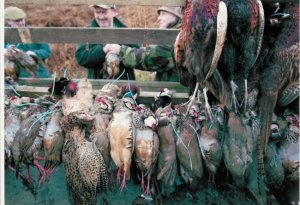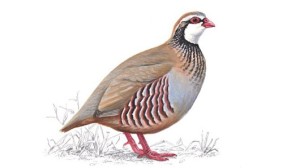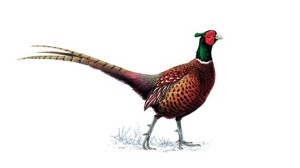 I just returned to Paris after a brief visit to the University of Aberdeen over the weekend. My hosts, Xavier Lambin and Beth Scott, were not only marvellously welcoming, I also learned a lot about the travesty that is game bird management in the United Kingdom, and especially in Scotland.
I just returned to Paris after a brief visit to the University of Aberdeen over the weekend. My hosts, Xavier Lambin and Beth Scott, were not only marvellously welcoming, I also learned a lot about the travesty that is game bird management in the United Kingdom, and especially in Scotland.
As you might already know, the Great Britons are a little cuckoo for birds — I’d even wager that the country produces more twitchers than any other country on Earth. The plus side is that there are few national taxa better censused and studied that British birds, because so many non-scientists get into the spirit of data collection. Hell, I’ve even had a play with some of their datasets.
The other side of this bird madness is not so good — I’m talking about the massive biomass of game birds reared, released and shot every year in the United Kingdom. It’s not the hunting per se with which I take issue, it’s the insane manipulation of an entire ecosystem for the benefit of a few species.
Xavier took us out around Aberdeenshire to see if we could see a few native grouse, and while we didn’t glimpse any black grouse (Tetrao tetrix), we saw heaps and heaps of red grouse (Lagopus lagopus). Black grouse aren’t doing so well, having declined in abundance by some 22 % in the last 10 years. There is an active habitat restoration programme despite the fact that this species is still a seasonal game bird. Red grouse are doing a little better, but are shot by the hundreds of thousands each year.
While those figures might shock a few, they’re nothing compared to what’s to follow. In addition to the red grouse, we saw bucket-loads of pheasant (Phasianus colchicus) and red-legged partridge (Alectoris rufa), neither of which is a native species (pheasants are, of course, an Asian species, and red-legged partridge come from Europe — mainly Spain).
Why we saw so many is really going to blow your mind — in the United Kingdom alone, 35 million pheasants are reared and released into the wild each year. That’s more than 1 pheasant for every two human beings in the country. While not as gob-smacking, there are 6.5 million red-legged partridge released there each year.
Yes, many of these are shot each year, but the corollary of such a huge biomass burden on the landscape cannot be understated. Let’s forget for a moment the amount of vegetation, fruit and insect biomass consumed by this heaving mass of shot fodder each year (that must decidedly reduce the carrying capacity for many other species), and instead focus on the management.
 I personally saw about five lethal kill traps set for ‘predators’ (mostly for weasels & stoats) within about half a kilometre along a road we walked, and Xavier tells me that he sees all manner of native birds killed by these in addition to the targeted predators. He also let loose an intriguing snippet — apparently the traps do bugger all to reduce most of the predator densities (although this information has allegedly been suppressed by the game management authorities). Little wonder too — with that extensive prey biomass buoyed artificially each year, there’s no doubt that incredibly high densities of predators are also maintained.
I personally saw about five lethal kill traps set for ‘predators’ (mostly for weasels & stoats) within about half a kilometre along a road we walked, and Xavier tells me that he sees all manner of native birds killed by these in addition to the targeted predators. He also let loose an intriguing snippet — apparently the traps do bugger all to reduce most of the predator densities (although this information has allegedly been suppressed by the game management authorities). Little wonder too — with that extensive prey biomass buoyed artificially each year, there’s no doubt that incredibly high densities of predators are also maintained.
The extent of the predator ‘control’ just to give some toffee-nosed, obese, champagne-sipping ‘hunters’ zero chance of missing the kill1 is, well, a little perverse. In the great perversion that is the United Kingdom’s biodiversity, this beggar’s belief. It only starts to make sense once you realise that game bird hunting is worth over £1.6 billion each year to the country’s economy.
Rather a dog’s breakfast, don’t you think?
—
1The birds are also ‘driven‘ (flushed) by mobs of (mostly) teenage boys toward the stationary ‘hunters’. It gives an entirely different slant to the verb ‘to hunt’.





[…] However, recreational hunting can also mean that predators are killed to make way for popular game species kept at artificially high densities via breeding and introduction programs. […]
LikeLike
[…] However, recreational hunting can also mean that predators are killed to make way for popular game species kept at artificially high densities via breeding and introduction programs. […]
LikeLike
[…] However, recreational hunting can also mean that predators are killed to make way for popular game species kept at artificially high densities via breeding and introduction programs. […]
LikeLike
Regular reader of these blogs. However as an ex- pom, 35 million is not one for every human being. Population of the UK is now around 63Million and England 53 Million :-)
LikeLike
I had meant to write: … for every two human beings …, but it was late. Corrected now, thanks.
LikeLike
I understood it was called a shoot rather than a hunt. Many years ago I was a grouse beater for a day or two and one of the most interesting events I recall was when a wealthy European shot the landowners wife. There was blood but no real injury luckily but the shooter was politely asked to leave. One up for the grouse?!
LikeLike
The hunting lobby is powerful and wealthy and you explore the issue thoughtfully and show the irony.
LikeLike
Great post….my conservation effort does not provide such huge turn-arounds as in the pheasants in the UK….. though I have some interesting results… http://www.gadoliforests.blogspot.in
LikeLike